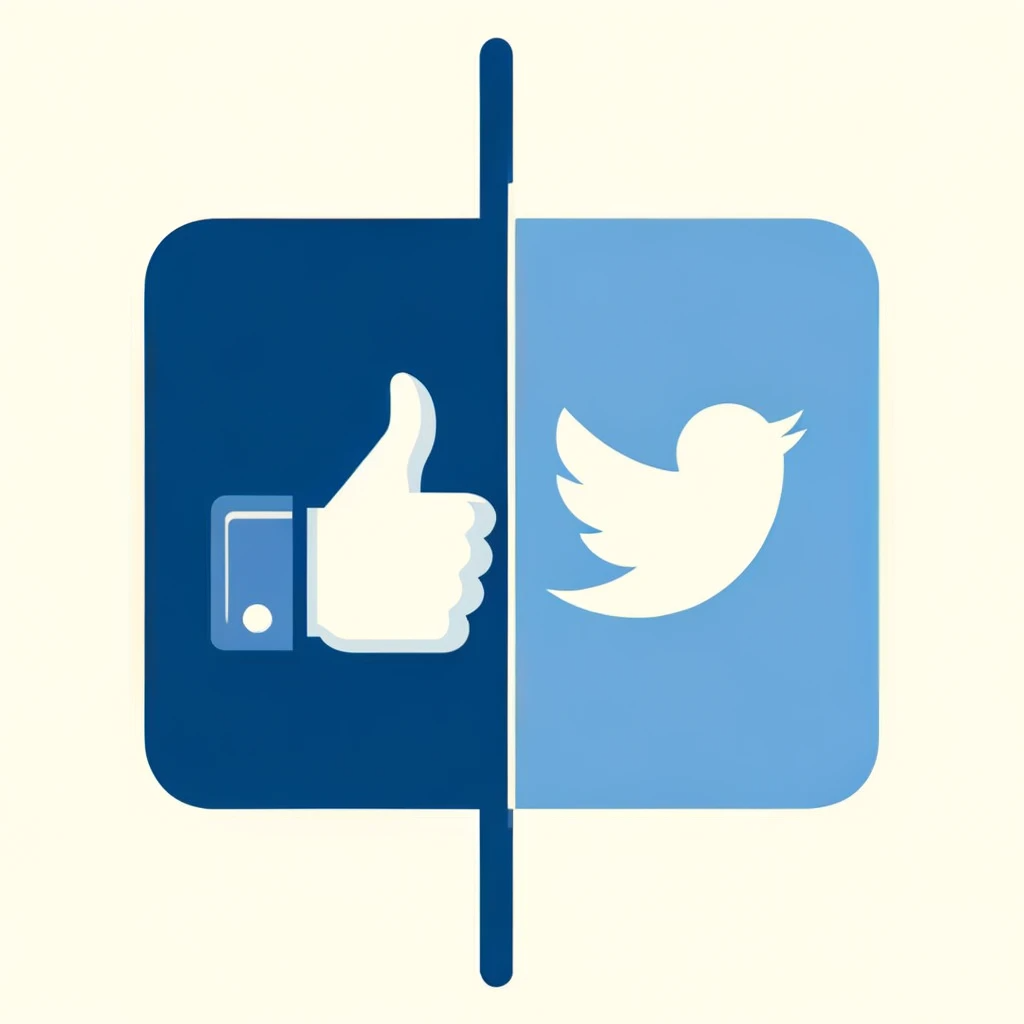- December 15, 2023
- Digital Marketing
Facebook vs Twitter: The Ultimate Battle for Social Media Supremacy

Social media has revolutionized the way we connect, engage, and share information. Among the frontrunners in this digital landscape are two giants: Facebook and Twitter. These platforms have become integral to our personal and professional lives, offering unique opportunities for businesses to connect with their target audience. But when it comes to choosing between Facebook and Twitter, which platform should your business invest in? In this comprehensive analysis, we will delve into the key differences and advantages of Facebook and Twitter, helping you make an informed decision that aligns with your business goals; especially given the fact that social media affects SEO in a large scale, highlighting the importance of having an extensive knowledge on this topic.
The Origins and Growth of Facebook and Twitter
Facebook, founded by Mark Zuckerberg in February 2004, began as a platform exclusively for Harvard students before expanding to other colleges and eventually opening its doors to the general public. With its user-friendly interface and diverse range of features, Facebook quickly gained traction and amassed a massive user base. As of 2023, Facebook boasts an estimated 2.94 billion monthly active users, making it the largest social networking platform in the world[^2^].
In contrast, Twitter emerged on the scene in March 2006, spearheaded by Jack Dorsey and his team. Twitter’s unique selling point lies in its microblogging format, allowing users to share short, concise messages known as “tweets.” Twitter gained popularity for its real-time information sharing capabilities and its role in facilitating public discussions and news updates. With an estimated 450 million monthly active users, Twitter continues to be a prominent platform for sharing ideas, engaging with trending topics, and connecting with a wider audience/
The Purpose and Primary Usage
To understand the differences between Facebook and Twitter, it is crucial to examine their respective purposes and primary usage patterns. Facebook primarily serves as a social networking platform, enabling users to connect with friends and family members. It focuses on fostering personal interactions and sharing updates, uploading and downloading photos, videos, and other content within a user’s network of acquaintances. Users can customize their profiles, join groups, and engage in private messaging to maintain connections with their personal circles.
On the other hand, Twitter differentiates itself as a microblogging platform designed for sharing quick updates, news, and opinions. While users can connect with friends and family members on Twitter, the platform’s main appeal lies in its ability to connect individuals to a wider network and facilitate conversations with like-minded individuals. Twitter’s character limit of 280 characters per tweet encourages users to be concise and share information in bite-sized snippets.
User Base and Demographics
When considering which platform to invest in, it is essential to understand the user base and demographics of Facebook and Twitter. Facebook boasts a staggering 70% penetration rate among U.S. adults, with approximately 80% of users falling within the 18-29 age bracket. The platform’s reach extends to older demographics as well, with 65% of people aged 50 and above using Facebook.
In comparison, Twitter’s user base is slightly smaller, with around 24% of U.S. adults actively using the platform. Twitter’s strength lies in its appeal to younger audiences, with 40% of users falling within the 18-29 age group. However, Twitter’s penetration among older demographics is significantly lower, with less than 20% of people aged 50 and above utilizing the platform.
Engagement and Usage Patterns
Engagement rates and usage patterns are crucial factors to consider when deciding between Facebook and Twitter. Twitter, with its real-time information sharing capabilities, attracts users who seek quick updates and trending news. Approximately 71% of Twitter users rely on the platform as a source of news, making it an ideal platform for businesses aiming to disseminate timely information[^3^]. Despite its smaller user base, Twitter’s engagement rates can be higher than other platforms, with click-through rates ranging from 1% to 3%.
In contrast, Facebook boasts the largest social media user base worldwide, with nearly 1.88 billion daily active users as of Q1 2021. The platform’s algorithm curates a personalized news feed for users, presenting them with content based on their preferences, engagement, and relevance. Facebook’s average click-through rate (CTR) stands at 0.119%, indicating a lower engagement rate compared to Twitter. However, Facebook’s extensive user base and diverse advertising tools make it a valuable platform for businesses aiming to reach a wider audience.
Advertising Opportunities
Both Facebook and Twitter offer advertising opportunities for businesses to promote their products and services. By creating a Facebook Business Page and utilizing Facebook’s advertising platform, businesses can narrow down their audience based on factors such as demographics, interests, and purchase behavior. The intuitive interface and relatively low cost of Facebook ads make it an attractive option for businesses, with daily budgets as low as $2 to $3 yielding significant results.
Twitter, while offering similar targeting capabilities, tends to be relatively more expensive when it comes to advertising. However, Twitter ads can yield higher engagement rates, with click-through rates reaching up to 1-3%[^3^]. Businesses looking to capitalize on real-time conversations, trending topics, and breaking news may find Twitter advertising a valuable investment.
Multilingual App Marketing offers a vital dimension to social media strategy, particularly in reaching diverse audiences and expanding market reach.
The Role of Instagram in the Social Media Landscape
While the focus of this analysis centers around Facebook and Twitter, it is essential to acknowledge the role of Instagram in the social media landscape. Instagram, a visual-centric platform, allows users to share photos and videos, creating a visually appealing narrative. With its emphasis on aesthetics and storytelling, Instagram offers businesses a unique opportunity to showcase their products and engage with their target audience.
Instagram’s user base predominantly consists of younger demographics, with 75% of users falling within the 18-24 age range. The platform’s engagement rates can vary based on the number of followers, with accounts between 1,000-5,000 followers averaging a 5.6% engagement rate[^3^]. For businesses aiming to create an interactive community and establish a visual brand identity, Instagram can be a powerful and complementary addition to their social media strategy.
Choosing the Right Platform for Your Business
When it comes to choosing between Facebook, Twitter, and Instagram, there is no one-size-fits-all solution. Each platform offers unique advantages and caters to different user demographics and engagement patterns. To make an informed decision, consider the following factors:
- Business Goals: Define your business goals and align them with the purpose of each platform. If your aim is to foster personal connections and engage with friends and family, Facebook may be the ideal choice. For real-time updates, news sharing, and engaging with a wider audience, Twitter can be the platform of choice. Instagram, with its visual storytelling capabilities, is well-suited for creating a visually appealing brand identity services and engaging with younger demographics.
- Target Audience: Analyze your target audience and their preferred social media platforms. Consider their age, interests, and online behavior to determine the platform that aligns closely with their preferences. Facebook’s broad user base covers a wide range of demographics, making it a versatile choice. Twitter appeals to a younger, trend-conscious audience, while Instagram attracts visually-oriented users.
- Content Strategy: Evaluate the type of content you intend to share and the format that best represents your brand. If your content relies heavily on text-based updates and long-form posts, Facebook’s extensive character limit and customizable profiles may be a better fit. For businesses that thrive on quick updates, news dissemination, and engaging with trending topics, Twitter’s microblogging format is ideal. Instagram’s visual nature makes it suitable for businesses aiming to showcase their products and create an appealing brand aesthetic.
- Advertising Opportunities: Consider your advertising goals and budget when assessing the advertising opportunities offered by each platform. Facebook’s extensive targeting capabilities and relatively low cost make it a popular choice for businesses of all sizes. Twitter’s higher engagement rates may justify a higher budget for businesses looking to capitalize on real-time conversations and trending news.
Conclusion
In the battle for social media supremacy, Facebook and Twitter emerge as formidable contenders, each offering unique advantages and catering to different user demographics. Facebook’s focus on personal connections and extensive user base make it an ideal platform for businesses aiming to engage with a broad audience. Twitter’s real-time information sharing capabilities and higher engagement rates attract users seeking quick updates and trending news. Instagram, with its visually appealing format, provides businesses with an opportunity to showcase their products and engage with younger demographics.
Ultimately, the choice between Facebook, Twitter, and Instagram depends on your business goals, target audience, content strategy, and advertising objectives. By carefully weighing these factors and analyzing the strengths of each platform, you can make an informed decision that aligns with your business objectives and maximizes your social media impact. So, choose wisely and embark on your journey to social media success!
Share it with your friends!
Explore
More
Ready to get started?
Harness the unmatched capabilities of ActionSprout to transform your Facebook strategy. Elevate engagement, captivate your audience, and achieve unparalleled results. Don’t wait – seize the opportunity.

